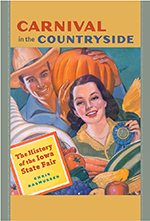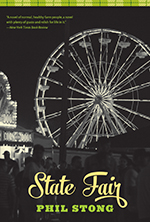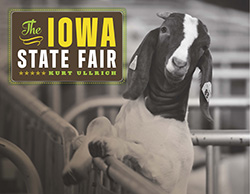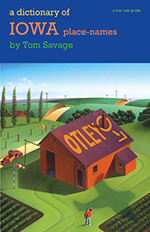Carnival in the Countryside
when prompted by shopping cart
“It is an outstanding study of the Iowa State Fair, one of the most readable studies of ‘outdoor entertainment’ that anyone has produced.”—Robert W. Rydell, coauthor, Fair America
“Chris Rasmussen’s Carnival in the Countryside offers a fascinating saga of one of the most heralded midwestern institutions of our day: the Iowa State Fair and its famous butter cow. Beyond Hollywood’s image of a young Pat Boone playing a strapping country boy adrift in Des Moines, beyond a nineteenth-century history that invites nostalgia for the family farm, the author puts the fair at the center of a critical debate over rural values versus urban ones, scandalous entertainments versus learning and enterprise, and the future of an Iowa that has managed to churn its disagreements into a proud independence of mind and spirit.”—Karal Ann Marling, author, Blue Ribbon: A Social and Pictorial History of the Minnesota State Fair
More than a century and a half after its founding, the Iowa State Fair is the state’s central institution, event, and symbol. New Jersey has the Shore; Kentucky has the Derby; Iowa has the Fair. The humble Iowa State Fairground ranks alongside the Great Pyramids at Giza and the Taj Mahal in the best-selling travel guide 1,000 Places to See Before You Die. During its annual run each August, the fair attracts hundreds of thousands of visitors who make the pilgrimage to the fairground to see the iconic butter cow, to ride the Old Mill, to walk through the livestock barns, and to people-watch. At the same time that they enjoy fried candy bars and roller coasters, Iowans also compete to raise the best corn and zucchinis, to make the best jams and jellies, to rear the finest sheep and goats, the largest cattle and hogs, and the handsomest horses.
This tension between entertainment and agriculture goes back all the way to the fair’s founding in the mid-1800s, as historian Chris Rasmussen shows in this thought-provoking history. The fair’s founders had lofty aims: they sought to improve agriculture and foster a distinctively democratic American civilization. But from the start these noble intentions jostled up against people’s desire to have fun and make money, honestly or otherwise—not least because the fair had to pay for itself. In their effort to uplift rural life without going broke, the organizers of the Iowa State Fair debated the respectability of horse racing and gambling and struggled to find qualified livestock judges. Worried about the economic forces undermining rural families, they ran competitions to select the best babies and the “ideal” rural girl and boy while luring spectators with massive panoramas of earthquakes and fires, not to mention staged trainwrecks. In short, the Iowa State Fair has as much to tell us about human nature and American history as it does about growing corn.






